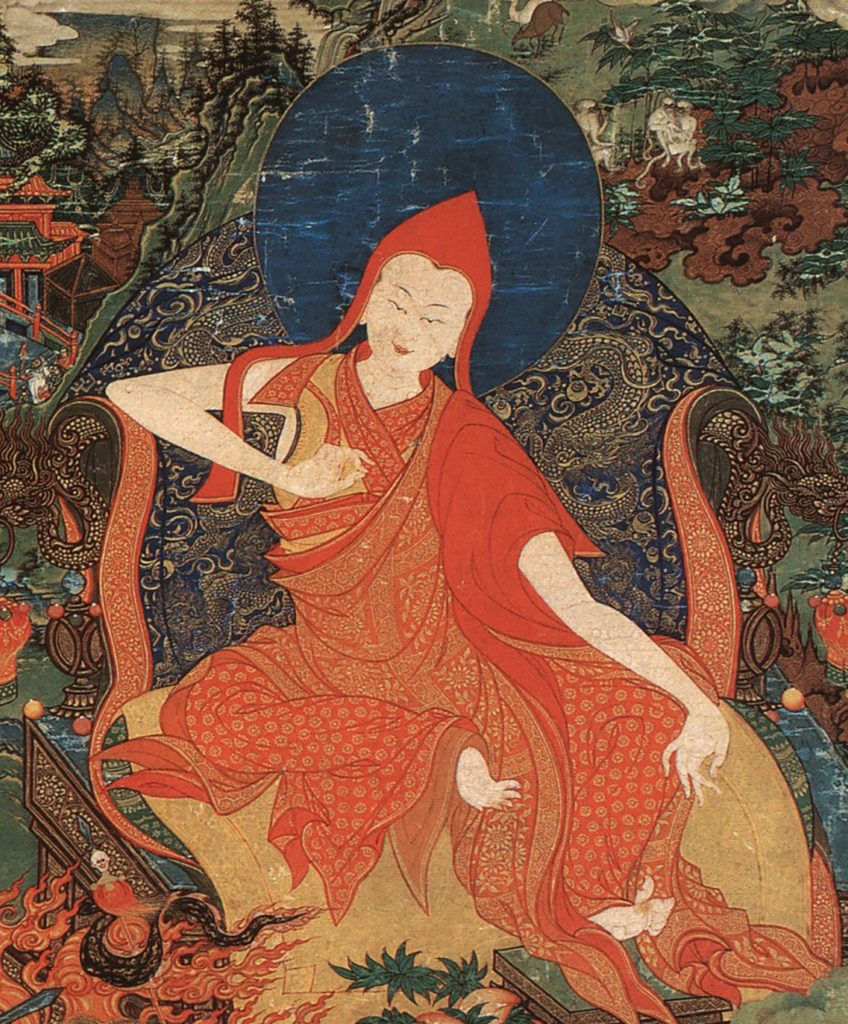Previous Lives
Forefather of the Sakyas
Sakya Pandita
 While most people are followers, a few rise to become leaders and fewer still become founding fathers, starting something that becomes so established that it grows to have hundreds of thousands of disciples. That is exactly the calibre of being that Sakya Pandita Kunga Gyaltsen was. One of the Five Sakya Forefathers credited with establishing the Sakya tradition of Tibetan Buddhism, this 13th Century scholar is said to be an emanation of Manjushri, the Buddha of Wisdom. Unsurprisingly, he was renowned as an expert scholar in the five great Buddhist sciences, and a formidable debater wherever Vajrayana Buddhism was present.
While most people are followers, a few rise to become leaders and fewer still become founding fathers, starting something that becomes so established that it grows to have hundreds of thousands of disciples. That is exactly the calibre of being that Sakya Pandita Kunga Gyaltsen was. One of the Five Sakya Forefathers credited with establishing the Sakya tradition of Tibetan Buddhism, this 13th Century scholar is said to be an emanation of Manjushri, the Buddha of Wisdom. Unsurprisingly, he was renowned as an expert scholar in the five great Buddhist sciences, and a formidable debater wherever Vajrayana Buddhism was present.
Born in 1182 to a noble family, Sakya Pandita’s life was filled with miraculous signs from the moment of his conception. Like the mothers of other great beings before him, Sakya Pandita’s mother had auspicious dreams whilst pregnant with him. Later, as an infant still at a crawling age, he spontaneously spoke to his mother in Sanskrit. It was impossible for him to have learnt the language at that time and at his age; it was obvious that he was recalling it from a previous life. By the time he was three, this remarkable boy could already read and write in Sanskrit, Tibetan, Chinese and Mongolian. Shortly after that, he could memorise complex tantric texts by heart.
It comes as no surprise therefore, that Sakya Pandita excelled in his studies which he began under his father. By the time he was 15, he had mastered all of the teachings held by the founders of Sakya, and had even given many teachings on tantra. He was known to be a formidable philosophical debater, invincible both on the debate floor as well as in written form. A prolific author of over 100 texts, as well as an accomplished translator who could instantly and accurately translate complex scriptures, his writings accurately refuted erroneous philosophical stances of his time, and many of them remain influential till this day.
There were instances throughout his life when Sakya Pandita demonstrated his clairvoyance, most famously publicly prophesying the year of his passing. There were also times when he demonstrated his tantric accomplishments, such as when he defeated an Indian pandit in debate. To escape conversion, the pandit flew into the air; Sakya Pandita merely clapped his hands and the pandit fell to the ground.
As Sakya Pandita’s reputation grew, so too did his influence which began to extend beyond Tibet’s borders. In 1244, he accepted an invitation to the court of the Mongol ruler Goden Khan, who wanted to strengthen the Mongols’ relationship with Tibetans in areas that they had annexed. Sakya Pandita’s journey to the court, accompanied by two of his nephews, took three years because he stopped along the way to give teachings and initiations, and perform rituals. It was his compassion that led this master to never forgo any opportunity to turn the Wheel of Dharma.
There are two versions concerning the way Sakya Pandita subdued the Mongols. One record states that when Sakya Pandita finally met Goden Khan, he cured the Mongol ruler’s skin condition, likely to have been leprosy. This immediately won the favour of the Mongols.
According to another traditional account, in an attempt to test Sakya Pandita, Goden Khan had his most powerful shamans conjure up an illusion of a temple so masterful that only a highly realised being with clairvoyance would be able to tell that it was not the real thing. As requested, Sakya Pandita blessed the temple, giving no indication that he realised it was an illusion. Feeling victorious, Goden Khan wanted to embarrass the master and so he signalled to his shamans to dissolve the illusion. However, regardless of whatever incantations they recited, they were unable to do so. After multiple attempts, Goden Khan realised that the temple had become real through Sakya Pandita’s realisations. Deep faith arose in the prince who then confessed what he had done, thereafter taking heartfelt refuge in Sakya Pandita.
Thanks to Sakya Pandita successfully establishing a priest-patron relationship with the ruling Mongol family, he was able to introduce Buddhism to Mongolia. During this time, Sakya Pandita also worked with one of his nephews, Phagpa, to create a written script specifically for the Mongol language. Phagpa would later go on to develop a spiritual relationship with Kublai Khan, the Mongol ruler who established the Chinese Yuan Dynasty.
In his lifetime, Sakya Pandita planted numerous seeds of Dharma in Mongolian history, thereby opening the doors to enlightenment for countless Mongols. By the end of his life, the entire nation of Mongolia was already on the path to accepting Buddhism as the state religion. In gratitude for his teacher’s service to the Mongol people, Goden Khan appointed Sakya Pandita as the temporal ruler of Tibet in 1249.
When Sakya Pandita entered clear light in 1251 just as he had prophesied, celestial instruments, music and songs of the dakinis were clearly heard by some, while those with clairvoyance saw victory banners and numerous other offerings appearing. At the moment of his parinirvana, the earth trembled which signified the passing of a great being. During his cremation, rainbows appeared amongst the funerary smoke and celestial music was heard; after the cremation, numerous relics and sacred pills were found amongst the ashes.
And thus, as miraculously as this master’s life had begun, so was it over at 69, ready to take another extraordinary rebirth to repeat and continue the remarkable deeds of his predecessor.
